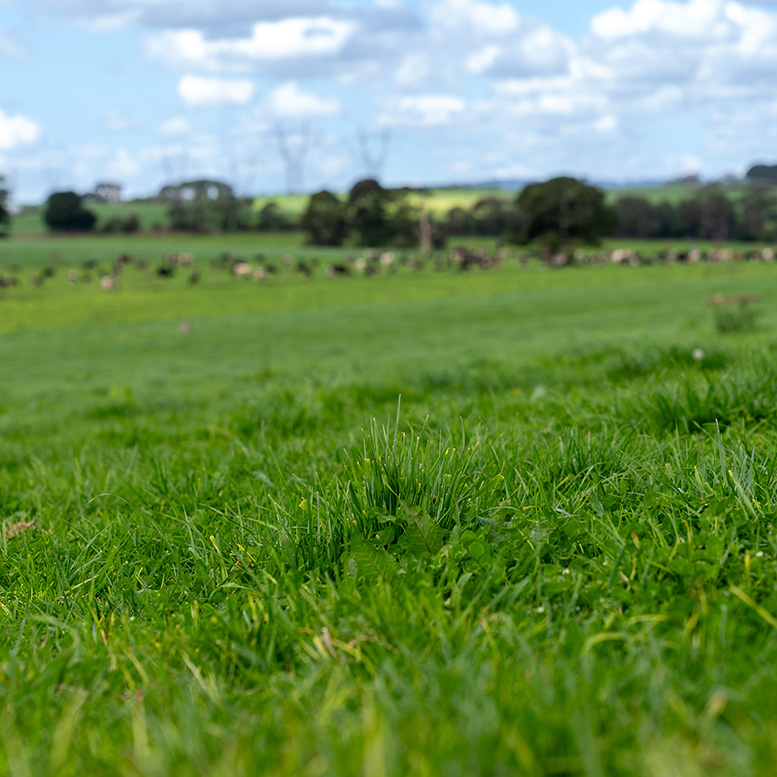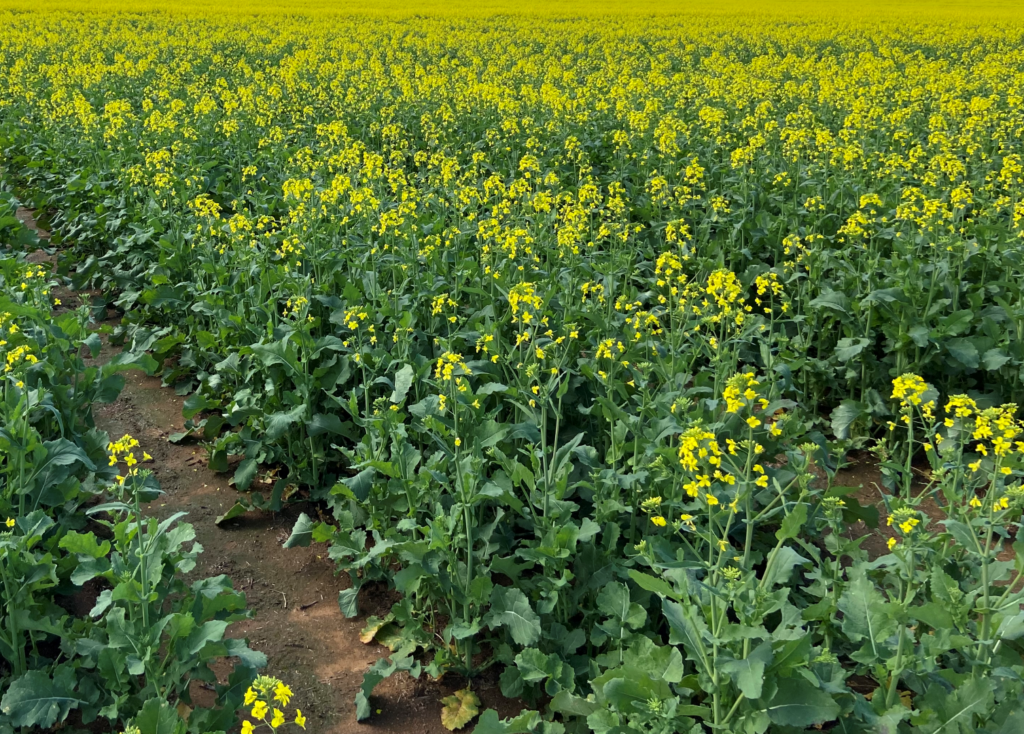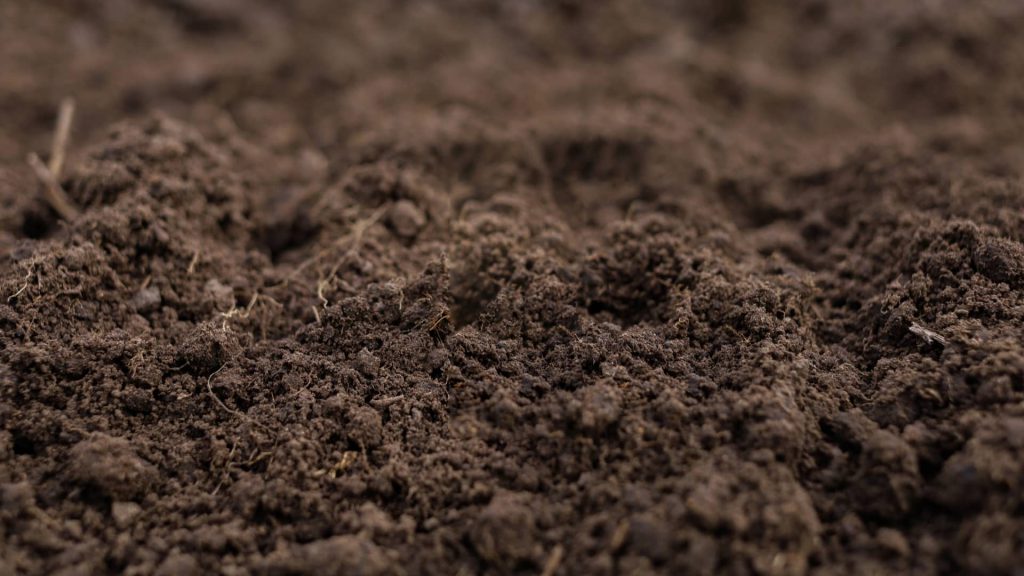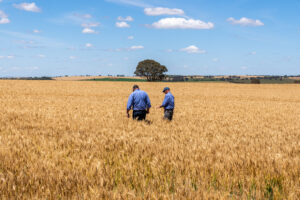Agronomic Insights
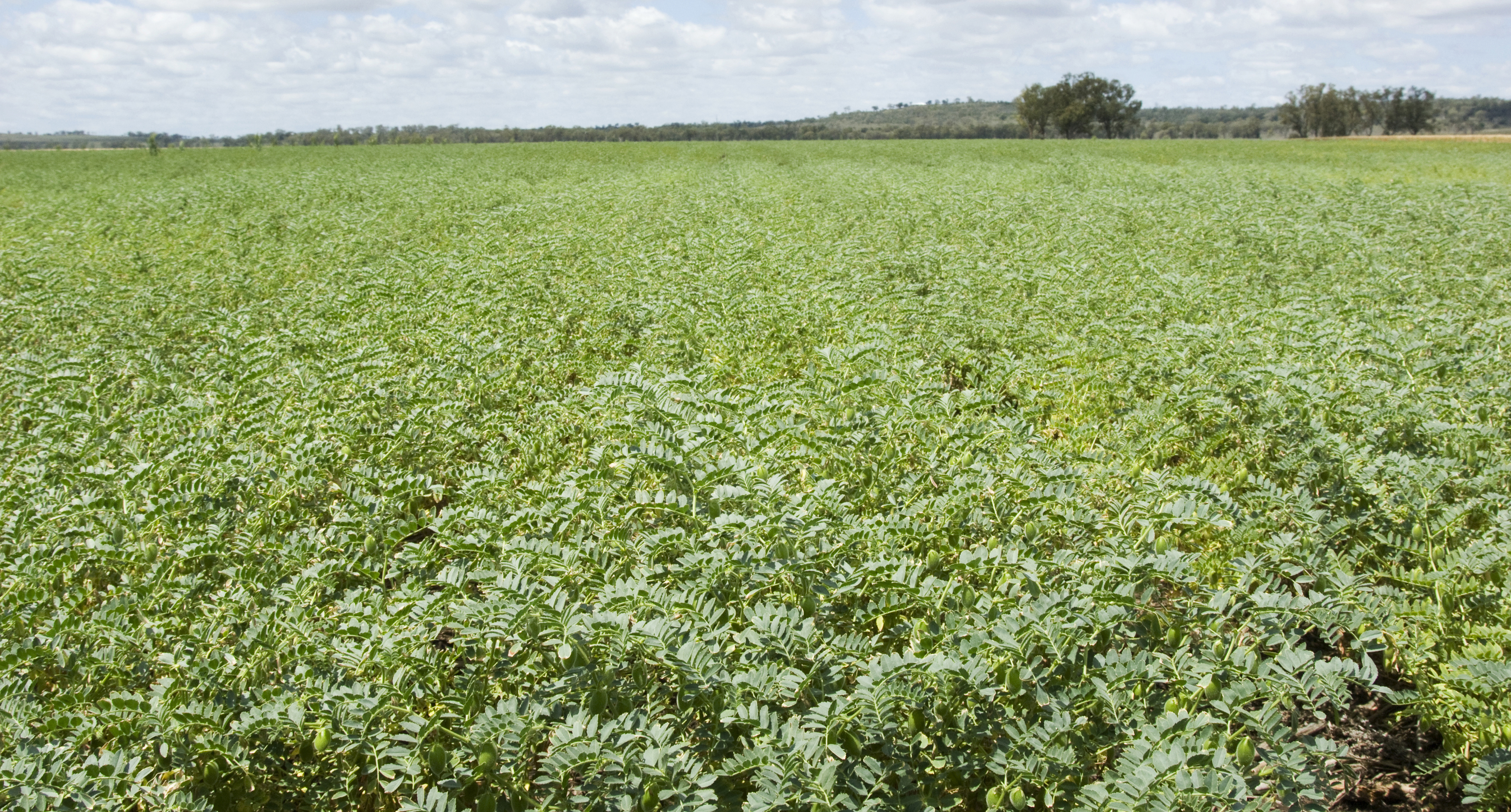
How much potassium can be banded with the seed at chickpea planting?
David McRae – IPF Technical Agronomist
Available soil potassium (K) is being stratified and negative K balances are common in our grain production systems. Consequently, emerging K deficiencies are reducing grain yields in some regions. This is a new situation and further research is required to quantify the effectiveness of K application strategies for current farming systems across different soil types.
Crops require large quantities of K to optimise plant growth and grain yield. The export of K varies with the type of enterprise (grazing, silage/hay making or grain production) and the crop type grown. According to agricultural production and fertiliser use data (which excludes recycled materials and manures), Australia has a negative K balance of approximately 400 kt/year (Norton 2017a). Meaning Australian production systems are removing 3.2 times more K than is being replaced.
Growers in Australia are generally fortunate as most of our east coast soils have adequate available K. However, current production systems that employ minimal or no deep cultivation and soil mixing have greater stratification of K in the surface soil and depleted subsoils.
Crops are taking up a significant proportion of their K requirements from the subsoil and returning K the surface layers in crop residues. Growers are then faced with increasingly complex nutrient management decisions (Bell et al. 2010, 2012).
Considerations
Soil testing for K is an important tool for monitoring and identifying soil nutrient status. Traditionally, calculations of K fertiliser requirements have been based on surface samples, which vary from 0-10cm to 0-30cm depths. However, in environments that receive low in-crop rainfall and rely on stored soil moisture, assessing the availability of K in the segment below the surface layer, e.g. 10-30cm, can help identify responsive situations.
Research conducted by Bell et al (2021) used cation exchange capacity (CEC) to differentiate soil types and potential fertiliser responses. Application of K fertiliser has been shown to increase exchangeable K concentrations more in lighter textured soils (lower CECs) than heavy textured soils (higher CECs). Figure 1 outlines suggested K application strategies which are most effective when applying K to different soils.
Determining the application rate, row spacing and the placement of the K fertiliser is important, i.e., soil surface, banded in the seed furrow or banded 20-30cm deep in the soil profile. Soil type and moisture conditions during the crop growth have a large influence on the suitability of application strategy.
For K application strategies to be effective, they need to enrich a sufficient volume of soil in the root zone and this zone remain adequately wet to allow root access and plant K uptake during critical growth periods.
Figure. 1: A tentative framework for allowing for the likely impact of key soil properties on choice of banding or broadcast K fertilizer application strategy in the soil (adapted from Bell et al 2021).
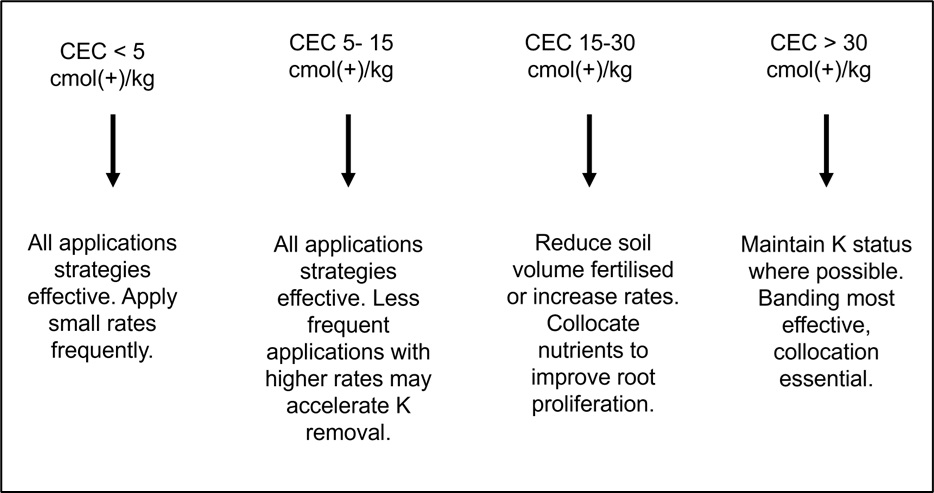
Chickpea trial
There has been increasing interest in applying K to chickpeas across NW NSW and southern Qld as soil K levels are declining and K stratification is becoming more prominent. Growers and agronomists have been considering their application strategies and seeking further information to support their decisions.
To investigate the safe application rate of K fertilisers when banded with chickpea seed at planting and the yield benefit of increasing rates of phosphorus (P) and K, Incitec Pivot Fertilisers (IPF) conducted a replicated trial approximately 35 km northeast of Moree in 2023.
The site had marginally low K in the surface sample (0-10cm) and was low in the 10-30cm sample (Table 1).
Table 1: Site soil analysis results for 0-10cm & 10-30cm samples
| Sample depth (cm) | Sample depth (cm) | |
| 0-10 | 10-30 | |
| Soil Texture | Clay | Silty clay |
| pH (1:5 water) | 7.61 | 8.19 |
| pH (1:5 CaCl2) | 6.82 | 7.15 |
| Chloride – mg/kg | 15 | 19 |
| Organic Carbon (W&B) – % | 0.55 | 0.41 |
| Nitrate Nitrogen – mg/kg | 12 | 9.8 |
| Phosphorus (Colwell) – mg/kg | 14 | <5 |
| Phosphorus (BSES) – mg/kg | 14 | <10 |
| Phosphorus Buffering Index | 59 | 69 |
| Sulphur (MCP) – mg/kg | 5.9 | 4.3 |
| Cation Exch. Cap. (CEC) – cmol(+)/kg | 25.9 | 28.3 |
| Calcium (Amm-acet.) – cmol(+)/kg | 17.1 | 18 |
| Magnesium (Amm-acet.) – cmol(+)/kg | 7.17 | 8.11 |
| Sodium (Amm-acet.) – cmol(+)/kg | 1.29 | 1.95 |
| Potassium (Amm-acet.) – cmol(+)/kg | 0.26 | 0.171 |
| Available Potassium – mg/kg | 102 | 67 |
| Sodium % of Cations (ESP) – % | 5.0 | 6.9 |
The trial was planted on the 29th May using 70 kg/ha of CBA Captain into sorghum stubble harvested in 2023 with 80cm of subsoil moisture.
The trial comprised of 10 starter fertiliser treatments (Table 2) with 4 replicates which was drilled into 12 x 2m plots on 32cm row spacings with narrow points. Potassium phosphate and potassium sulphate fertilisers were chosen as the K source as they have higher seed safety than potassium chloride (KCl).
Table 2: Starter fertiliser products and nutrient application rates. Note: Potassium source was either potassium sulphate or potassium phosphate
| Treatment | Rate | P (kg/ha) | K (kg/ha) |
| Untreated | – | 0 | 0 |
| GRANULOCK Z | 35 kg/ha | 7.6 | 0 |
| GRANULOCK Z | 70 kg/ha | 15.3 | 0 |
| ChicKP (S) Zn | 70 kg/ha | 7.7 | 12.6 |
| ChicKP (S) Zn | 140 kg/ha | 15.4 | 25.2 |
| N-K Blend | 45 kg/ha | 0 | 12.9 |
| N-K Blend | 90 kg/ha | 0 | 25.8 |
| EASY LIQUIDS 1 | 55 L/ha | 7.7 | 12.5 |
| EASY LIQUIDS 1 | 110 L/ha | 15.3 | 25 |
| EASY LIQUIDS 2 | 115 L/ha | 15.8 | 34 |
Results of plant counts are shown in Figure 2, with no significant difference between treatments. Plant counts in the high starter treatments appear to be slightly less than other treatment. However, this result was not surprising as these rates were thought to be marginally safe.
Figure 2: Average treatment plant count results conducted 4 weeks after planting
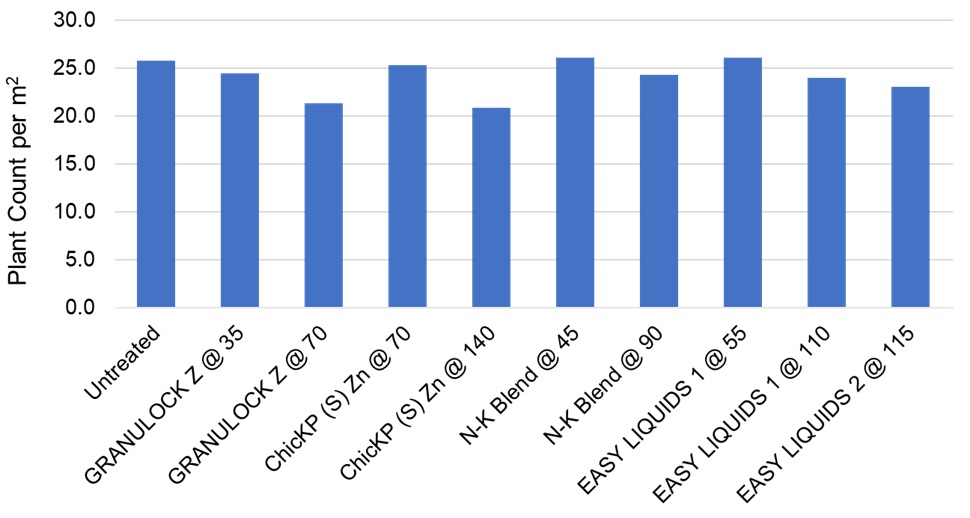
The site received no effective rainfall from planting to harvest. As a result, low grain yields were recorded at harvest (Figure 3). There was no response to any fertiliser treatment applied at planting. The availability of seed furrow placed nutrients would have been low as they were stranded in dry soil for a significant period of crop growth. This meant that crop nutrient uptake was reliant on the availability of nutrients in the lower soil levels.
Figure 3: Chickpea grain yield results
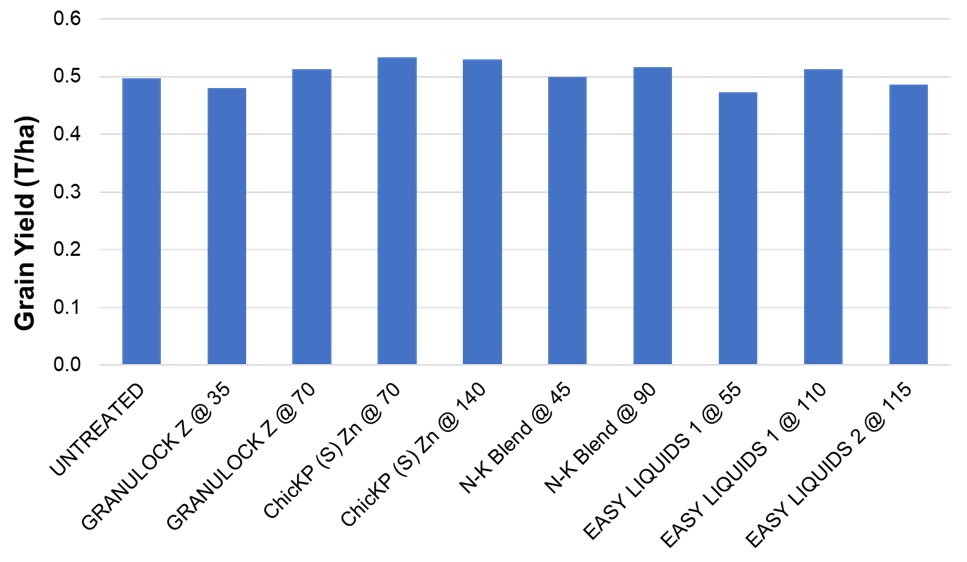
Conclusion
Soil testing your fields with 0-10cm and 10-30cm sampling depths will help to identify K fertiliser requirements.
When determining the safe fertiliser rate to be banded in the seed furrow at planting the key factors to consider are crop type, soil texture, soil moisture, row spacing, width of furrow and nutrient form.
Effective K application strategies enrich an adequate volume of soil of the root zone that remains wet for a significant part of the crop’s life.
Further Information
For further information, please feel free to contact me on david.mcrae@incitecpivot.com.au or 0477 987 321.
You can also contact Bede O’Mara on 0417 896 377 bede.omara@incitecpivot.com.au
Reference
Bell MJ, Lester DW (2012). Multiple nutrient deficiencies in northern grains cropping – latest resultsand management responses for system profitability. (https://grdc.com.au/404.aspx?item=web%3a%7b08BFE968-6F06-4F8F-87E6-34CF39133691%7d%40en) In ‘Grains Research Updates.'(GRDC: Goondiwindi)
Bell MJ, Mallarino AP, Volenec J, Brouder S, Franzen DW (2021). Considerations for Selecting Potassium Placement Methods in Soil. In ‘Improving Potassium Recommendations for Agricultural Crops’. (Eds T. S. Murrell et al. (eds.), pp. 341-362. https://doi.org/10.1007/978-3-030-59197-7_12
Bell MJ, Moody PW, Klepper K, Lawrence DN (2010). The challenge to sustainability of broadacre grain cropping systems on clay soils in northern Australia. In ‘Proceedings of the 19th World Congress of Soil Science; Soil Solutions for a Changing World. ‘(Eds. RJ Gilkes and N Prakongkep) pp. 302-305. (IUSS:Brisbane, Australia)
Norton R (2017a) Potassium removal and use in Australia. In ‘Proceedings for the frontiers of potassium science conference’. 25–27 January 2017, Rome, Italy. (Eds TS Murrell, RL Mikkelsen) pp. O34–O44. (International Plant Nutrition Institute: Peachtree Corners, GA, USA)
Resources
DOWNLOAD INSIGHTDISCLAIMER
This is a guide only, which we hope you find useful as a general tool. While IPF has taken all reasonable care in the preparation of this guide, it should not be relied on as a substitute for tailored professional advice and IPF accepts no liability in connection with this guide. Incitec Pivot Fertilisers manufactures and sources fertilisers from other suppliers. The fertiliser supply chain extends beyond the company’s direct control, both overseas and within Australia. Incitec Pivot Fertilisers hereby expressly disclaims liability to any person, property or thing in respect of any of the consequences of anything done or omitted to be done by any person in reliance, whether wholly or in part, upon the whole or any part of the contents of this article.


